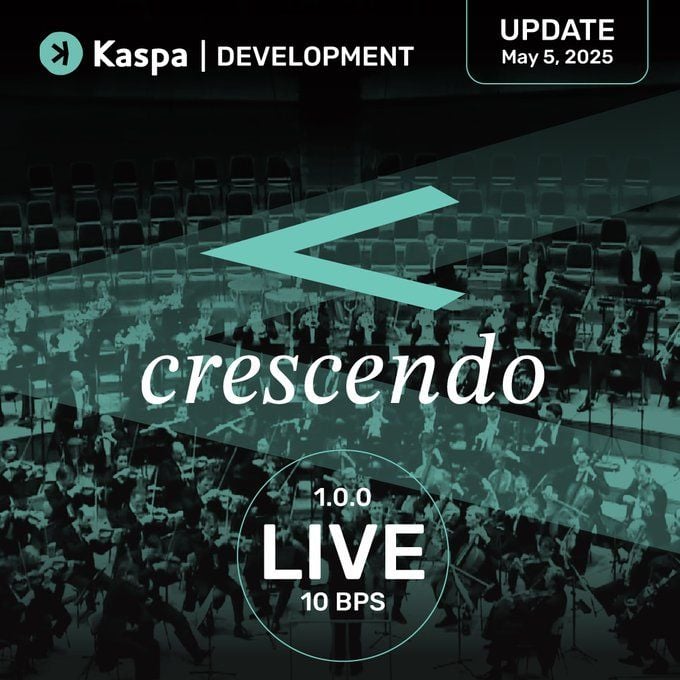News
(Advertisement)
Kaspa Crescendo v1.0.0 Goes Live With Major Network Overhaul

The hardfork is powered by Rusty Kaspa, the project's Rust rewrite, and introduces Protocol Version 7, mandatory for all nodes from May 4, 2025.
Soumen Datta
May 6, 2025
(Advertisement)
Table of Contents
The much-awaited Kaspa Crescendo v1.0.0 has officially gone live, bringing a significant transformation to the Kaspa network.
This hardfork marks a monumental leap in blockchain technology, enhancing the network’s speed and scalability. Kaspa’s approach has always been unique, using a BlockDAG structure powered by GHOSTDAG for high efficiency. With the Crescendo update, the network’s block production will reportedly skyrocket from 1 block per second (BPS) to 10 BPS.

What Is the Crescendo Hardfork?
The Crescendo Hardfork is a mandatory update that will trigger significant changes within the Kaspa blockchain. Initially announced in April 2025, the update officially took effect on May 5, 2025, when the network’s Difficulty Adjustment Algorithm (DAA) score hit 110,165,000, at approximately 15:00 UTC.
The hardfork is a direct result of the work done on Kaspa Improvement Proposal (KIP)-14, which outlined the technical upgrades for increasing the block production rate.
One of the most notable changes is the increase in the block production rate from 1 BPS to 10 BPS, which will drastically reduce the time between blocks from 1,000 milliseconds to just 100 milliseconds. This will allow Kaspa to process more transactions, offering faster confirmation times and improving overall network capacity.
The Need for Faster Blockchain Technology
In today’s world, blockchain networks are striving to find a balance between speed, security, and decentralization—a challenge commonly known as the blockchain trilemma. Kaspa’s transition to 10 BPS addresses these issues by increasing throughput without compromising decentralization or the security provided by its Proof of Work consensus mechanism.
Kaspa’s GHOSTDAG protocol, which allows multiple blocks to be processed simultaneously, makes it a standout in the world of blockchain. With the Crescendo upgrade, the network can handle a higher volume of transactions while maintaining its decentralized nature. The reduced block times mean that transactions can be confirmed faster, a critical step for practical use cases such as payments and decentralized applications (dApps).
Key Features of Kaspa Crescendo v1.0.0
The Crescendo Hardfork introduces several major upgrades to Kaspa. Some of the standout features include:
Increased Block Production Rate
As mentioned, the block production rate will jump from 1 BPS to 10 BPS, allowing Kaspa to process transactions faster than ever before. This upgrade positions Kaspa as one of the fastest Proof of Work networks in existence today.
Enhanced Data Retention and Storage
One of the essential aspects of the update is the new retention-period-days setting for node operators. This gives operators the flexibility to choose how long historical data will be retained on their nodes.
With the faster block rate, the default pruning period for data will drop from 50 hours to 30 hours, which means that more storage may be required unless the operator adjusts the setting. This is especially important as Kaspa ramps up its transaction throughput.
Transition to Protocol Version 7
Kaspa nodes will switch to P2P Protocol Version 7 24 hours before the hardfork takes effect. This new protocol version ensures that all nodes on the network will be able to communicate efficiently and stay connected as the system transitions to the upgraded version.
Technical Enhancements in KIP-14
The Kaspa Improvement Proposal (KIP)-14 is the primary blueprint for this hardfork, and it includes several technical enhancements designed to ensure that the network can handle the increased speed and transaction volume. Some of the key changes are:
- Increased GhostDAG K Parameter: The GhostDAG K parameter will rise to 124, allowing for better block processing.
- Increased Maximum Block Parents: The maximum number of block parents will rise from 10 to 16, improving the network's capacity to handle multiple parallel blocks.
The Impact of Crescendo on Miners, Node Operators, and Users
With Kaspa’s market cap currently valued at $2.46 billion, the Crescendo upgrade has major implications for miners, node operators, and users alike.
Impact on Miners
For miners, the transition to 10 BPS means an increase in competition, as more blocks will be produced per second. With over 1,090 PH/s of hashrate already powering the network, miners will need to adapt to the changes brought about by this upgrade. This could lead to more efficient mining operations, though it might also make it more challenging for individual miners to remain profitable.
Impact on Node Operators
Node operators will need to upgrade their software to v1.0.0. Those who do not upgrade will end up forking off into an obsolete chain, effectively losing their ability to participate in the main Kaspa network after May 5, 2025. The new data retention settings introduced in the hardfork will require more storage, especially for those who choose to keep historical data for a longer period.
Impact on Users
For users, the Crescendo upgrade translates into faster transaction confirmations. With the reduction in block time, Kaspa will become a more efficient platform for various use cases, including payments, remittances, and decentralized applications. This upgrade also boosts Kaspa’s scalability, positioning it to handle a higher volume of transactions as adoption increases.
The Road Ahead for Kaspa
Kaspa’s Crescendo Hardfork paves the way for greater mainstream adoption, enabling the network to support emerging use cases such as decentralized finance (DeFi), smart contracts, and tokenized assets.
The Kaspa team believes that this hardfork will be transformative, not only for the network but also for the broader blockchain space. They envision Kaspa playing a key role in real-world applications ranging from digital payments to infrastructure projects.
With its combination of speed, security, and decentralization, Kaspa is on track to deliver a platform capable of supporting the next generation of blockchain innovation.
Read Next...
Disclaimer
Disclaimer: The views expressed in this article do not necessarily represent the views of BSCN. The information provided in this article is for educational and entertainment purposes only and should not be construed as investment advice, or advice of any kind. BSCN assumes no responsibility for any investment decisions made based on the information provided in this article. If you believe that the article should be amended, please reach out to the BSCN team by emailing [email protected].
Author
 Soumen Datta
Soumen DattaSoumen has been a crypto researcher since 2020 and holds a master’s in Physics. His writing and research has been published by publications such as CryptoSlate and DailyCoin, as well as BSCN. His areas of focus include Bitcoin, DeFi, and high-potential altcoins like Ethereum, Solana, XRP, and Chainlink. He combines analytical depth with journalistic clarity to deliver insights for both newcomers and seasoned crypto readers.
(Advertisement)
Latest News
(Advertisement)
Crypto Project & Token Reviews
Project & Token Reviews
Comprehensive reviews of crypto's most interesting projects and assets
Learn about the hottest projects & tokens














